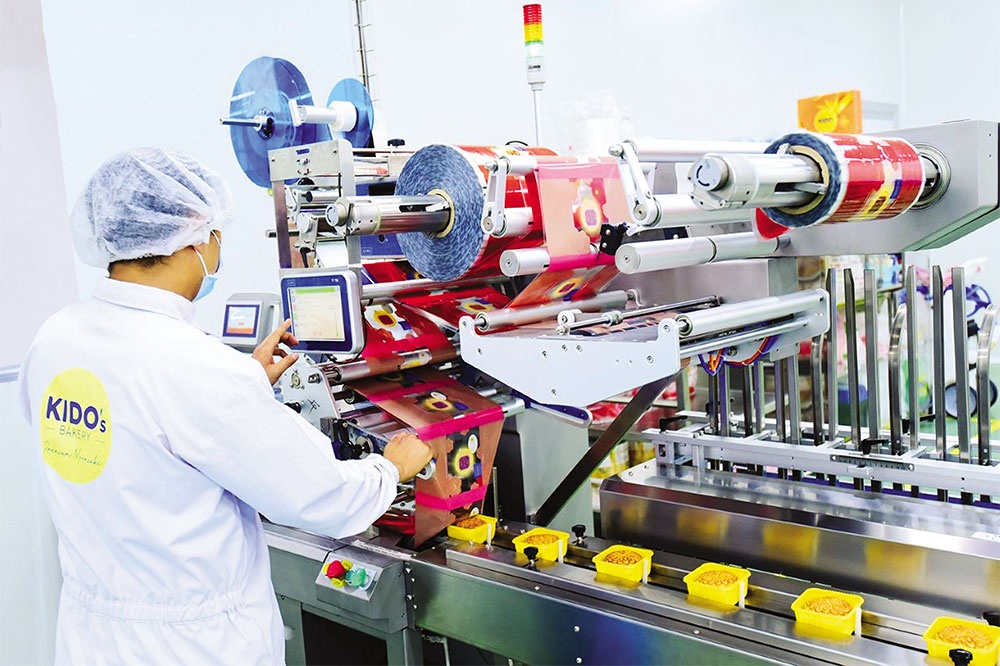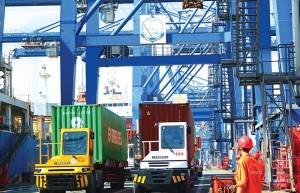Developing the economy through global value chains
Vietnam’s remarkable success in reducing poverty and improving living standards over recent decades has been driven by public investments in human development and infrastructure, and progress in developing market institutions, competitive markets, and regional and global economic integration.
 |
| Economist Raymond Mallon |
Foreign trade and investment have supported economic growth via increased investment, competition, new product and service markets, and better access to inputs and technological innovation. Deepening links with global value chains (GVCs) have helped sustain the productivity growth that has underpinned improved living standards in Vietnam. GVCs help boost productivity through increased efficiency and ongoing interaction with the whole value chain to improve know-how and extend access to international research and development, and innovation.
Vietnam’s success in linking with GVCs is reflected in the expansion and greater sophistication of electronics and information technology manufacturing, and the increasing numbers of domestic firms engaging with foreign investors to innovate and expand business opportunities. Domestic firms not directly linked to GVCs still learn from innovations introduced by firms linked to GVCs.
The net result has been a rapid increase in the complexity of Vietnam’s economy. Harvard Growth Lab’s analysis indicates that Vietnam increased its economic complexity ranking, from 93rd in the world in 2000, to 52nd in 2020. Arguing that growth is driven by diversifying into increasingly more complex production, Harvard researchers concluded that Vietnam’s economic growth will be one of the fastest in the world in the coming decade.
GVCs both stimulate innovation and generate increased demand for services. Thus, the labour force share of trade and logistics services, business, and financial services (and healthcare and other social services), are likely to increase over time, while that of labour-intensive manufacturing will decline.
International experience shows that as countries develop, the value-added and employment generated from GVCs increasingly depend on economic activities other than manufacturing. In Vietnam, recent strong employment growth in labour-intensive manufacturing is slowing because of the more capital-intensive nature of complex production systems, and because of rising wages associated with improved living standards. The use of robotics in VinFast’s Haiphong car plant is a concrete example of this trend.
Thus, sustained progress in generating new and more productive jobs outside of labour-intensive manufacturing will be crucial if Vietnam is to avoid the so-called middle-income trap. Providing quality employment opportunities requires actions to address both the demand and supply side labour market challenges.
Policymakers and planners need to both anticipate and plan for economic restructuring driven by market forces, while also facilitating labour market restructuring. Planners will need to formulate strategies to boost vocational and higher-level skills in areas of high demand, while also formulating and implementing policies that target more, and better, jobs for the less skilled workers, including jobs outside the main urban areas.
 |
| Vietnam’s economy is expected to continue to develop in complexity with increasingly strong links to global economic partners, Le Toan |
Cooperation prospects
The new-generation regional economic cooperation agreements, such as the Regional Comprehensive Economic Partnership (RCEP), provide new opportunities for Vietnam to respond to those challenges by targeting a broader scope of economic cooperation than offered by tariff reductions under free trade agreements.
The RCEP, as well as the Comprehensive and Progressive Agreement for Trans-Pacific Partnership, aim to move towards region-wide harmonisation of trade facilitation measures such as rules of origins, simplified management of certificates of origin, and standards. Resulting reductions in information costs, combined with already high levels of digital literacy and adoption of information technology, is helping Vietnam move up the value chain.
Recent agreements focus more on facilitating trade in services, including e-commerce, financial services, telecommunications services and increased mobility for businesspeople and professionals. Internationally, growth in such services has been linked to increased average wages. Realising potential benefits from increased trade in services implies a need for more skilled workers.
Regional cooperation is helping Vietnam to exploit its emerging strengths in e-commerce, software development, big data and data services, artificial intelligence, financial services, and other business services to access emerging opportunities in RCEP member countries. FPT’s increasing exports of services to support digital manufacturing, AI, and automation are one concrete example of Vietnam’s emerging potential in this area.
Regional agreements are also facilitating the increased use of digital platforms by both national and regional businesses. When combined with the streamlining of trade administration systems, the accelerated development of online trading and information platforms can help ensure more equitable outcomes from integration by transforming opportunities for small- and medium-sized enterprises (for example in agro-industry) to participate in trade and regional production networks.
Other regional agreements address broader constraints to greater regional links including developing and/or reforming infrastructure, institutions, rules and regulations, and people-to-people links. ASEAN’s Connectivity Master Plan identifies five focus areas: sustainable infrastructure, digital innovation, seamless logistics, regulatory excellence, and people mobility. Accelerated progress in these areas could further accelerate Vietnam’s shift towards more complex and higher productivity economic systems.
Potential policy responses
The question then is, what public policy measures can be taken to facilitate the economic transformation to continue improving living standards? Improving human capital and physical infrastructure, developing market institutions, growing competitive markets, and boosting business investment remain obvious priorities.
But there will also be a need for actions that directly target the development of supporting services and other business services to implement simpler and more effective service licensing systems for service sub-sectors; reduce administrative barriers and costs to trade in services; provide service sector-oriented vocational and higher education skills to meet services-related skills shortages; facilitate regional mobility of personnel; and invest in quality digital infrastructure. This is in addition to the power supply and other physical infrastructure, including outside the main urban centres. Extending support to regional initiatives such as the ASEAN Qualifications Referencing Framework could help over the longer term.
Developing strategies and actions to sustain gains from increasing complexity and integration requires ongoing collaboration between domestic and foreign businesses, government agencies, and applied research institutions. Continued support to provide skilled workers and quality infrastructure, possibly with targeted support for applied research and the transfer of technologies to facilitate transitions into emerging growth opportunities, would also help.
In providing public support, targeted outcomes-oriented strategies and actions are more likely to be effective than open-ended subsidies or tax incentives. Changes to the Law on Intellectual Property, to take effect in 2023, may also help increase investment in GVCs.
Understanding the overall and distributional impacts of integration and restructuring, and taking action to support groups adversely impacted by change, will be important for both equity reasons and for sustaining broad-based support for integration.
As Vietnam continues to move up the value chain it will also need to give more attention to addressing domestic and global concerns about the environment, labour standards, transparency, and the equitable treatment of all businesses.
Vietnam’s economy will continue to develop in complexity with increasingly strong links to external economic partners and GVCs. The added value from GVCs will extend beyond the manufacturing sector as the complexity of the Vietnamese economy increases. Firms benefiting from these trends can be expected to contribute to national targets for investment, productivity growth, and employment. The net result should be sustained strong and increasingly more diversified economic growth.
Key policy challenges to maximising the benefits from these trends include developing the skills, infrastructure, and institutions needed to attract investors into increasingly complex economic activity – while also identifying and mitigating against potential negative impacts on some groups in society and on the environment. Ensuring that a broader range of businesses and their workers benefit from these trends will both help boost the domestic economy and sustain public support for regional and global economic links.
 | Outlook for improved growth in new year Last year, I was overly optimistic about the time it would take to control the pandemic and to ease domestic and international travel restrictions. But despite continuing uncertainties, the prospects for the Vietnamese economy have improved since the 6.02 per cent contraction in the very difficult Q3 of 2021, and there are now reasons to be cautiously optimistic about the prospects for a return to stronger economic performance in 2022. |
 | Importance of CPTPP deal to Vietnam’s economic success The Comprehensive and Progressive Agreement for Trans-Pacific Partnership (CPTPP) is attracting the attention of potential new member economies. Senior Australian economist Raymond Mallon writes about how possible enlargement will impact Vietnam’s economy, trade, and investment attraction, and potential obstacles and opportunities. |
What the stars mean:
★ Poor ★ ★ Promising ★★★ Good ★★★★ Very good ★★★★★ Exceptional
Related Contents
Latest News
More News
- Pivotal stage of growth paves way for rise in M&As (December 03, 2025 | 10:00)
- Positive projections for M&A interest from Thailand (December 03, 2025 | 09:40)
- Manifesting the first line of defence in cybersecurity (December 03, 2025 | 09:00)
- The transformational role AI can play in accounting arena (December 03, 2025 | 08:00)
- Unlocking 5G-AI potential in Singapore (December 03, 2025 | 08:00)
- Data-driven strategies vital for a fast-evolving nation (December 02, 2025 | 09:41)
- Policy to practice: how Vietnam can lead the region (November 26, 2025 | 16:03)
- Mobilising private capital at scale vital for climate battle (November 26, 2025 | 15:36)
- VILAF and Yoon & Yang launch Vietnam - Korea Practice Unit (November 26, 2025 | 15:16)
- Trademark disputes challenge foreign firms in Vietnam (November 24, 2025 | 15:30)

 Tag:
Tag:






















 Mobile Version
Mobile Version